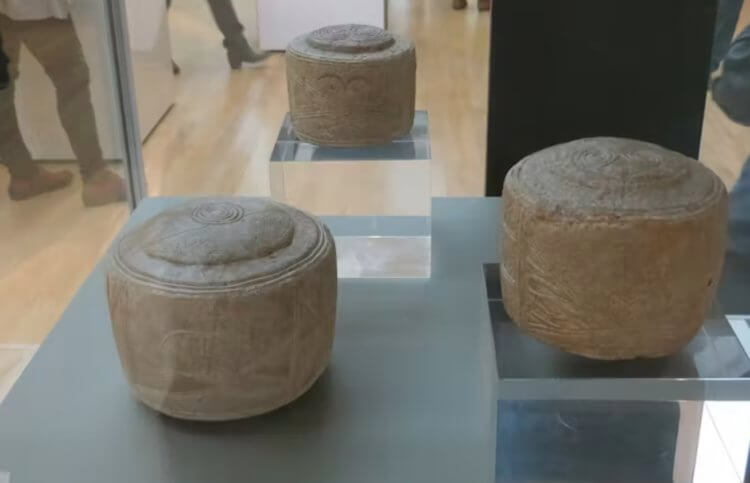Archaeologists find hundreds or even thousands of ancient objects every year. Often these are all kinds of jewelry, household appliances, and so on — scientists know perfectly well how and for what they were used. But sometimes, in layers of the earth and inside ancient structures, things are discovered whose origin raises a lot of questions. For example, once in the Czech Republic, a huge book with 310 pages was found, which contain the full text of the Bible. It weighs 75 kilograms, so at least two people are needed to move it. The handwriting in the book is the same, so scientists believe that it was created by the same person, and it took him 30 years to do this. Today, this book, written by no one knows who and for what purpose, is kept in one of the museums in Stockholm (Sweden). There are other, no less interesting finds that have not yet been explained.

Contents
- 1 Stone balls of Scotland
- 2 Dodecahedron of ancient times
- 3 Ancient drums in England
- 4 Golden rings of ancient times
- 5 Ancient lizard statues
Stone balls of Scotland
Small “balls” made of stones are discovered from time to time in Scotland. They date back to 3200-2500 BC, meaning they were made by ancient Stone Age people.

Mysterious stones of the late Neolithic era. Source: atlasobscura.com
To date, scientists have managed to find 425 stone balls. All of them are the size of a tennis ball and have a structure with round bulges. Some of them were found in human burial places, while others were found in homes. In one place you can find no more than a couple of round stones, that is, they were used one at a time, they were not included in any sets.

Stone balls found in Scotland. Source: sciencealert.com
Judging by the damage, the ancient people handled the stone balls roughly. There is an assumption that they were used to scare away predators. According to another version, these stones served as measuring weights. Or maybe it's just home decorations. Scientists still cannot understand what these stones were needed for, although the very first of them were found back in the 19th century.
Dodecahedron of ancient times
In 2024, a discovery in the English county of Lincolnshire caused a lot of controversy. Archaeologists managed to find 130 ancient dodecahedrons – hollow polyhedra of 12 regular pentagons with round holes of different diameters. Scientists believe that they were made during the times of Ancient Rome, but there are no mentions of them in the documents of those times.

Ancient Roman dodecahedron. Source: livescience.com
The dodecahedrons were made of copper alloy. There are no signs of wear on them, which could indicate what they were used for. So today scientists have hundreds of ancient artifacts at their disposal, the purpose of which is a big mystery.
Ancient Drums in England
Since the late 18th century, archaeologists have found cylinders carved from chalk. They are called chalk drums – in 1889, three specimens were found in Faulkton, England. They lay in the grave next to the body of the child and were decorated with designs resembling a human nose, eyes and eyebrows. In 1993, another chalk drum was found in Sussex, but it was not decorated with anything. But a specimen from East Yorkshire discovered in 2015 had many interesting decorations.

Mysterious chalk drums. Source: sciencealert.com
Despite the name, these products are unlikely to have been used as musical percussion instruments. In any case, there are no signs on their surfaces that they were often tapped with hands. Scientists suggest that the drawings on the chalk drums are somehow connected with astrological phenomena, but no evidence of this has been found.
Read also:The rarest archaeological finds – photographs and facts< /p>
Golden rings of ancient times
During the Bronze Age, people made objects not only from bronze, but also from gold. For example, many gold rings dating back to 1000-800 BC have been found in parts of Ireland, Great Britain and France. They usually came in pairs and also had simple engravings.

It would be logical to think that these are jewelry to be worn on the ears or nose. It can also be assumed that people used these gold rings to decorate their hair. But their design is such that it was impossible to wear them on any part of the body. But what were these mysterious products intended for? At the moment, science cannot give a concrete answer.
Ancient statues of lizards
Around 6500–3800 BC, representatives of the Ubaid culture lived in the territory of modern Iraq. This culture is characterized by the development of agriculture, ceramics and the first settlements. For its time, it was a very developed culture, so scientists often find its artifacts.

You might think that these figurines depict aliens. Source: mru.ink
What surprises archaeologists most are figurines in the form of lizard-like people. One could say that they depict some ancient gods. However, these figures are completely different from those discovered earlier. Conspiracy theorists believe that these figurines indicate the existence of reptilians. But science simply cannot give an exact answer.
Have you already subscribed to our Zen channel? If not, now is the time to do it!
At the beginning of the article we mentioned a huge book, which is sometimes called “devilish”. You can read more about it in the article “Archaeological finds that still have no explanation.”